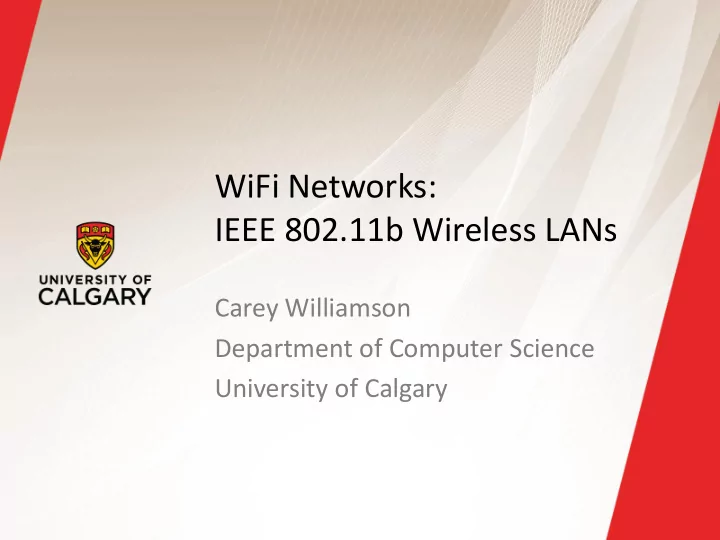

WiFi Networks: IEEE 802.11b Wireless LANs Carey Williamson Department of Computer Science University of Calgary
Background (1 of 2) ▪ In many respects, the IEEE 802.11b wireless LAN (WLAN) standard is similar to that for classic IEEE 802.3 (Ethernet) LANs ▪ Similarities: — LAN with limited geographic coverage — multiple stations, with 48-bit MAC addresses — shared transmission medium (broadcast technology) — CSMA-based Medium Access Control protocol — comparable data rates (11 Mbps vs 10 Mbps)
Background (2 of 2) ▪ But there are also many distinct differences: — wireless (air interface) versus wired (coax) — wireless propagation environment (multipath) — higher error rate due to interference, etc. — successful frames are ACKed by receiver — mobile stations versus fixed stations — half-duplex versus full-duplex operation — “hidden node” and “exposed node” problems — potential asymmetries of links — CSMA/CA versus CSMA/CD — multiple data transmission rates (1, 2, 5.5, 11)
Some WiFi Features ▪ Infrastructure mode vs “ad hoc” mode ▪ Access Point (AP) sends “beacon frames” — Mobiles choose AP based on signal strength ▪ Multiple channel access protocols supported — CSMA/CA (DCF); PCF; RTS/CTS ▪ MAC-layer can provide error control, retransmission, rate adaptation, etc. ▪ Direct Sequence Spread Spectrum (DSSS) — signal spread across 14 22-MHz channels
Where Does Wireless RF Live? ISM (Industrial, Scientific, Medical) band 902-928 MHz 2400-2483.5 MHz 5725-5850 MHz Old Wireless 802.11a 802.11/802.11b,g Bluetooth Cordless Phones Home RF Baby Monitors Microwave Ovens
Protocol Stack View Application Telnet, FTP, Email, Web, etc. Presentation Session TCP, UDP Transport IP, ICMP, IPX Network Logical Link Control - 802.2 (Interface to the upper layer protocols) Data Link MAC Wireless lives at 802.3, 802.5, 802.11 Layers 1 & 2 only! Physical Layer Convergence Protocol Physical LAN: 10BaseT, 10Base2, 10BaseFL WLAN: FHSS, DSSS, IR
Wireless Cells Access Point coverage area is called a “Cell” Access Point 11 Mbps bandwidth Channel 6 “ shared ” by all devices ESSID: NAI in the Cell! Range per Access Point is 100m • In Canada/US, there are eleven 802.11 channels • Only channels 1, 6 and 11 are non-overlapping • Computers can roam between cells
Multiple Wireless APs 1 1 6 11 11 1
Medium Access Control (MAC) Carrier Sense Multiple Access with Collision Avoidance How CSMA-CA works: • Device wanting to transmit senses the medium (Air) • If medium is busy - defers • If medium is free for certain period (DIFS) - transmits Latency can increase if “air” is very busy! Device has hard time finding “open air” to send frame! * DIFS - Distributed Inter-Frame Space (approx 128 µs)
MAC Protocol (Cont’d) source others dest “Air” is free DIFS for DIFS time NAV: defer access period send frame data All other devices must defer SIFS while “air” is busy Receive ACK ack that frame was received intact! • Every frame is acked - except broadcast and multicast! * SIFS - Short Inter-Frame Space (approx 28 µs)
MAC-Layer Retransmission ▪ If no ACK received “right away”, then the sender retransmits the frame again at the MAC layer — indicates frame (or ACK) was lost/corrupted — very short timeout (e.g., 1 msec) — exponential backoff (doubling) if repeated loss ▪ Typically recovers before TCP would notice ▪ Max retransmission limit (e.g., 8) ▪ May do MAC-layer rate adaptation or frame fragmentation if channel error rate is high
Other MAC Protocols Supported ▪ Point Coordination Function (PCF) — AP polls stations in turn to see if frames to send — useful for real-time traffic ▪ Request-To-Send/Clear-To-Send (RTS/CTS) — reservation-based approach (ask permission) — useful for very large frames — useful for solving the “hidden node” problem — request asks for clearance (permission) to send — request also indicates time required for transmit
Frame Formats ▪ Two frame formats available: — long preamble — short preamble ▪ Configuration option for NIC and AP ▪ Variable-size frames (max 2312 data bytes) ▪ 16-bit Cyclic Redundancy Code (CRC) for error checking of frames
Frame Format (Long Preamble) Long Preamble = 144 bits • Interoperable with older 802.11 devices • Entire Preamble and 48 bit PLCP Header sent at 1 Mbps Transmitted at 1 Mbps Signal Length 16 bit 16 bit Service Speed Payload of Start 128 bit Preamble CRC (unused) 1,2,5.5, 0-2312 bytes Payload Frame (Long) 11 Delimiter Mbps Transmitted at X Mbps
Frame Format (Short Preamble) Short Preamble = 72 bits • Preamble transmitted at 1 Mbps • PLCP Header transmitted at 2 Mbps • more efficient than long preamble Transmitted Transmitted Transmitted at at at 2 Mbps 1 Mbps X Mbps Signal Length 16 bit 16 bit Speed Service Payload of Start 56 bit CRC (unused) 1,2,5.5, 0-2312 bytes Payload Frame Preamble 11 Delimiter Mbps
Even More Features ▪ Power Management — mobile nodes can “sleep” to save power — AP will buffer frames until client requests them — AP can use virtual bitmap field in beacons to indicate which stations have data waiting ▪ Security — Wired Equivalent Privacy (WEP) — not very secure at all!
Summary ▪ IEEE 802.11b (WiFi) is a wireless LAN technology that is rapidly growing in popularity ▪ Convenient, inexpensive, easy to use ▪ Growing number of “hot spots” everywhere — airports, hotels, bookstores, Starbucks, etc ▪ Many deployments now have IEEE 802.11g (54 Mbps) or IEEE 802.11a (also 54 Mbps) ▪ Some deployments have IEEE 802.11n (> 100 Mbps) ▪ U of C WLAN has about 1000 WiFi Access Points (APs)
Recommend
More recommend